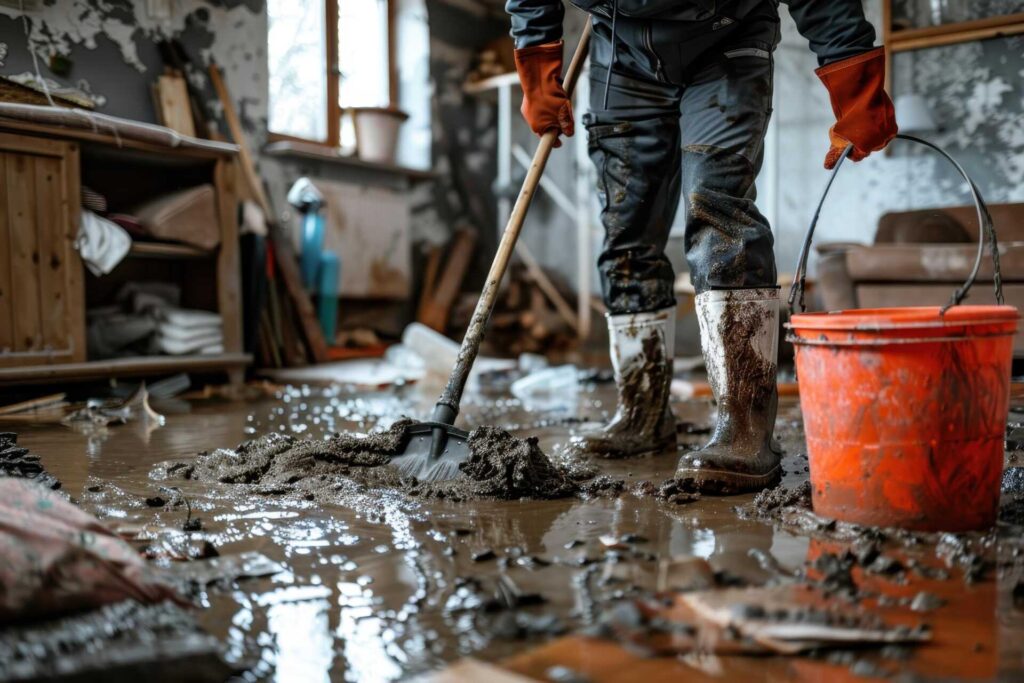
Contents
When facing flood cleanup, it’s essential to approach the situation methodically. Start by evaluating the damage and prioritizing safety. You’ll need to gather the right tools and supplies to effectively remove water and debris. Cleaning and disinfecting affected areas is critical to prevent mold growth. Understanding how to tackle these steps can make a significant difference in your home’s recovery. Let’s explore the fundamental strategies you’ll need to implement for effective cleanup and mold prevention.
Key Takeaways
- Remove standing water promptly using wet/dry vacuums to prevent further damage and mold growth.
- Clean and disinfect all affected surfaces with EPA-approved cleaners to eliminate contaminants.
- Dry out spaces thoroughly with fans and dehumidifiers to reduce humidity levels below 60%.
- Repair damage with moisture-resistant materials and apply mold-resistant paint on surfaces.
- Conduct regular inspections for moisture and mold, maintaining proper ventilation in all areas.
Assessing the Damage After a Flood
After a flood, it’s crucial to quickly assess the damage to determine the necessary cleanup steps. Start by evaluating the flood severity; this will guide your next actions. Look for water levels, structural integrity, and affected materials. Document everything with photos and notes to support insurance claims later.
Begin your damage assessment by checking the foundation, walls, and floors for cracks or buckling. Pay close attention to electrical systems and appliances, as these can pose risks if damaged. Inspect furnishings and personal belongings; some may be salvageable, while others will need disposal.
Don’t forget to assess moisture levels in various areas; hidden dampness can lead to mold growth.
Safety Precautions During Cleanup
During cleanup, it’s essential to prioritize your safety by wearing protective gear, such as gloves and masks.
Ensure electrical safety by disconnecting power in affected areas to prevent shock hazards.
Additionally, ventilate spaces to reduce humidity and minimize mold growth.
Wear Protective Gear
When tackling flood cleanup, wearing protective gear is essential for your safety. Proper gear selection shields you from contaminants and minimizes the risk of injury. Invest in high-quality protective clothing, including gloves, masks, and waterproof boots.
| Gear Type | Purpose |
|---|---|
| Gloves | Protect hands from debris |
| Masks | Filter harmful air particles |
| Waterproof Boots | Keep feet dry and safe |
| Coveralls | Shield skin from exposure |
Ensure Electrical Safety
Ensuring electrical safety is crucial as you navigate the cleanup process after a flood.
Start by performing a thorough electrical inspection of your home. Before entering the premises, make sure to execute a power shutdown to avoid any risk of electrocution.
If water has seeped into electrical outlets or appliances, don’t attempt to turn them on; this can lead to severe hazards.
Consider hiring a licensed electrician to assess the damage and verify all systems are safe to use.
Always keep an eye out for any unusual sounds or odors when restoring power.
Your safety is paramount, and taking these precautions protects you and fosters a sense of community well-being as you rebuild together.
Ventilate Affected Areas
To effectively combat mold growth and improve air quality after a flood, you’ll need to ventilate affected areas as soon as possible.
Proper air circulation is vital to minimize humidity levels and prevent mold proliferation. Open windows and doors, and use fans to enhance airflow. If possible, dehumidifiers can further assist in humidity control.
- Confirm all windows and doors are opened to promote cross-ventilation.
- Use fans strategically to direct airflow through damp areas.
- Monitor indoor humidity levels with a hygrometer to maintain ideal conditions.
Essential Tools and Supplies for Flood Cleanup
Flood cleanup requires a specific set of tools and supplies to effectively tackle the aftermath of water damage.
First, gather a reliable wet/dry vacuum to remove standing water quickly. You’ll also need heavy-duty trash bags for debris disposal. A sturdy mop and bucket will help with residual moisture, while fans and dehumidifiers are essential for drying out your space.
Don’t forget protective gear, including gloves, masks, and boots, to keep you safe from contaminants. A moisture meter can help you identify hidden damp areas.
Keep your flood insurance documents handy, as you may need to file claims or seek assistance. Finally, have a list of emergency contacts ready, including local restoration services, to expedite your cleanup process.
With the right tools and supplies, you can effectively manage flood cleanup and reduce the risk of mold growth.
Removing Water and Drying Out Your Home
First, assess the extent of water damage in your home to determine the necessary steps for effective cleanup.
Use proper equipment, such as pumps and dehumidifiers, to remove standing water and facilitate drying.
Swift action is essential to minimize damage and prevent mold growth.
Assess Water Damage
Evaluating water damage is essential for effective cleanup and mold prevention.
Start with a thorough damage assessment to identify affected areas and prioritize your actions. Document everything for potential insurance claims, as this can expedite your recovery process.
- Check ceilings and walls for discoloration or bulging.
- Inspect flooring and carpets for saturation or warping.
- Assess personal belongings for damage.
Use Proper Equipment
To effectively remove water and dry out your home, you’ll need to use the right equipment. Start with proper gear such as waterproof gloves and boots to protect yourself.
Invest in specialized tools like submersible pumps to extract standing water quickly and dehumidifiers to reduce humidity levels. High-velocity fans can also help circulate air and facilitate drying.
Don’t forget moisture meters to monitor the drying process and ensure no hidden dampness remains. Using these tools speeds up the cleanup and helps prevent mold growth, keeping your home safe.
Cleaning and Disinfecting Affected Areas
Begin by removing any standing water and debris from the affected areas to minimize further damage.
Once you’ve done that, it’s crucial to clean and disinfect thoroughly. Use appropriate cleaning solutions to eliminate contaminants and bacteria. Implement effective disinfecting techniques to ensure surfaces are free from pathogens.
- Choose EPA-approved disinfectants for enhanced safety.
- Pay special attention to high-touch areas like doorknobs and countertops.
- Allow cleaning solutions to sit for the recommended time to maximize effectiveness.
After cleaning, verify that the area is well-ventilated to facilitate drying, which helps prevent mold growth.
Identifying and Addressing Mold Growth
Mold growth can quickly become a serious issue after a flood, making it vital to identify it early. Start by using mold identification techniques like visual inspections and smell tests.
Look for discoloration on walls, ceilings, and floors, as well as damp, musty odors. If you suspect mold but can’t see it, consider using moisture meters to pinpoint hidden areas with high humidity.
Once you’ve identified mold, it’s important to act swiftly with effective mold remediation methods. For small patches, you can use a mixture of water and detergent to scrub the affected areas.
However, for larger infestations, it’s best to consult professionals who can ensure thorough removal and prevent future issues.
Preventing Future Mold Growth
While evaluating your home for potential mold issues, it’s crucial to implement preventive measures that can considerably reduce the likelihood of future growth.
Start by utilizing mold-resistant materials in areas prone to moisture, such as bathrooms and basements. This simple step can greatly hinder mold’s ability to thrive.
Additionally, maintain proper air filtration within your home. A well-maintained HVAC system with high-efficiency particulate air (HEPA) filters can help reduce airborne mold spores and maintain a healthier environment.
Consider these key strategies:
- Control humidity levels: Keep indoor humidity below 60% using dehumidifiers.
- Ventilation: Ensure adequate airflow in all rooms, especially areas with water sources.
- Regular inspections: Routinely check for leaks and moisture accumulation to catch issues early.
Restoration and Repair After Cleanup
Once you’ve completed the cleanup process, it’s vital to focus on restoration and repair to ensure your home returns to a safe and livable condition.
Start by evaluating the structural integrity of your home. Identify any damage to walls, floors, and ceilings that may require immediate attention. Employ restoration techniques such as drying out materials thoroughly and replacing any irreparably damaged components.
Consider repair options like patching drywall, replacing flooring, or reinforcing structural elements. It’s important to use moisture-resistant materials to prevent future issues.
Be sure to address plumbing and electrical systems, as flood damage can compromise their safety.
After repairs, apply mold-resistant paint and sealants to protect surfaces. Regularly inspect your home for signs of moisture or mold growth to confirm long-term safety.
When to Call in Professional Help
How can you determine when it’s time to call in professional help after a flood? Recognizing the right moment is vital for effective recovery. If your damage assessment reveals extensive issues or if you’re unsure about the safety of your environment, don’t hesitate to seek expert assistance.
Consider calling professionals if:
You’re dealing with significant structural damage that may compromise safety.
Mold growth is visible, or you suspect hidden mold due to prolonged moisture exposure.
You’re uncertain about filing a flood insurance claim and need guidance.
Professionals can provide specialized equipment and expertise to ensure thorough cleanup and mold prevention.
They’ll help you navigate the complexities of flood recovery while safeguarding your home and health.
Review
In the aftermath of a flood, the contrast between safety and chaos is stark. Prioritizing protective measures while methodically addressing water damage ensures a healthier home environment. As you tackle cleanup and mold prevention, remember that diligence today can prevent costly repairs tomorrow. By staying vigilant with inspections and maintaining proper humidity levels, you can safeguard your space against future threats. Don’t hesitate to seek professional help when needed; sometimes, expert assistance is the key to restoring peace of mind.
Recent Posts
What Are the Top Mold Prevention Tips After Flooding?
You might think mold prevention isn’t a priority after flooding, but it’s essential for your
Essential Mold Prevention Tips Post-Flooding
Imagine standing in a damp, musty room, where the remnants of floodwater linger and the
Ultimate Flood Cleanup and Restoration Strategies
When faced with the aftermath of a flood, it’s essential to approach the flood cleanup
